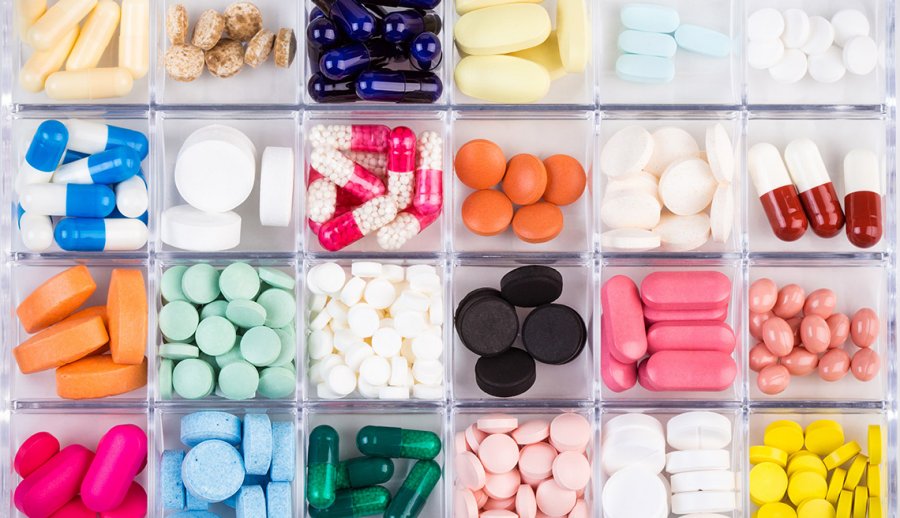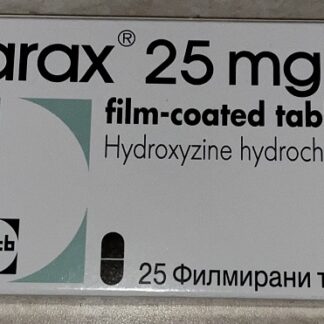Description
See the products from the drop down menu.
Serotonin and noradrenaline reuptake inhibitors (SNRIs) are used to treat major depression, mood disorders, and possibly but less commonly attention deficit hyperactivity disorder (ADHD), obsessive-compulsive disorder (OCD), anxiety disorders, menopausal symptoms, fibromyalgia, and chronic neuropathic pain.
SNRIs raise levels of serotonin and norepinephrine, two neurotransmitters in the brain that play a key role in stabilizing mood.
Examples include duloxetine (Cymbalta), venlafaxine (Effexor) and desvenlafaxine (Pristiq).
Selective serotonin reuptake inhibitors (SSRIs) are the most commonly prescribed antidepressants. They are effective in treating depression, and they have fewer side effects than the other antidepressants.
SSRIs block the reuptake, or absorption, of serotonin in the brain. This makes it easier for the brain cells to receive and send messages, resulting in better and more stable moods.
They are called “selective” because they mainly seem to affect serotonin, and not the other neurotransmitters.
Examples include citalopram (Celexa), escitalopram (Lexapro), fluoxetine (Prozac, Sarafem), fluvoxamine (Luvox), paroxetine (Paxil) and sertraline (Zoloft).
Tricyclic antidepressants (TCAs)
Tricyclic antidepressants (TCAs) are so named because there are three rings in the chemical structure of these medications. They are used to treat depression, fibromyalgia, some types of anxiety, and they can help control chronic pain.
Examples include amitriptyline (Elavil), amoxapine- clomipramine (Anafranil)
Monoamine oxidase inhibitors (MAOIs)
This type of antidepressant was commonly prescribed before the introduction of SSRIs and SNRIs.
It inhibits the action of monoamine oxidase, a brain enzyme. Monoamine oxidase helps break down neurotransmitters, such as serotonin.
If less serotonin is broken down, there will be more circulating serotonin. In theory, this leads to more stabilized moods and less anxiety.
Doctors now use MAOIs if SSRIs have not worked. MAOIs are generally saved for cases where other antidepressants have not worked because MAOIs interact with several other medications and some foods.
Examples of MAOIs include phenelzine (Nardil), tranylcypromine (Parnate), isocarboxazid (Marplan) and selegiline (EMSAM, Eldepryl).
Noradrenaline and specific serotoninergic antidepressants (NASSAs)
These are used to treat anxiety disorders, some personality disorders, and depression.
Examples include Mianserin (Tolvon) and Mirtazapine (Remeron, Avanza, Zispin).
WELLBUTRIN is used to treat depressive disorders. WELLBUTRIN is thought to interact with substances in the brain called norepinephrine and dopamine, which have been linked to depression.
Unless otherwise prescribed by your doctor, the starting dose of the medicine is:
150 mg / 1 tablet / once daily.
If there is no improvement after a few weeks of treatment, your doctor may prescribe a higher dose – 2 tablets a day.
Take your dose of WELLBUTRIN in the morning.
Do not take more than 1 tablet at a time. The interval between doses should be at least 8 hours.
Duloxetine 60 mg * 30 | Venlafaxine XR 75 mg prolonged release capsules * 30 by MEDOCHEMIE | Anafranil (clomipramine) 25 mg * 30 by NOVARTIS | Fluvoxamine maleate 100 mg * 30 MYLAN | Amitriptyline 25 mg * 30 by MYLAN | Mirtazapine 30 mg * 30 by ACTAVIS | Selegiline hydrochloride 5 mg * 30 MEDOCHEMIE | Citalopram 20 mg * 30 ACTAVIS | Prozac Fluoxetine 20 mg * 24 Lilly | Escitalopram 10 mg * 28 | Venlafaxine 75 mg prolonged release capsules * 30 MEDOCHEMIE | Trazodone 150 mg prolonged release tablets * 20 AngeliniPharma | Agomelatine 25 mg * 30 GEROT | Vortioxetine Fonksera 5 mg * 28 LUNDBECK | EDRONAX (reboxetine) 4 mg * 60 PFIZER | Tianeptine 12.5 mg * 30 SERVIER | Flupentixol/melitracen 0.5/10 mg * 100 LUNDBECK | Wellbutrin (bupropion) XR 150 mg * 30 GlaxoSmithKline
Amitriptyline has an average rating of 7.5 out of 10 from a total of 1,702 reviews on Drugs.com. 68% of reviewers reported a positive experience, while 17% reported a negative experience.
| Condition | Avg. Rating | Reviews | Compare |
|---|---|---|---|
| Migraine Prevention Off-label | 359 reviewsfor Migraine Prevention | 34 medications | |
| Insomnia | 275 reviewsfor Insomnia | 119 medications | |
| Pain | 246 reviewsfor Pain | 1136 medications | |
| Anxiety and Stress | 178 reviewsfor Anxiety and Stress | 9 medications | |
| Irritable Bowel Syndrome Off-label | 145 reviewsfor Irritable Bowel Syndrome | 124 medications | |
| Depression | 133 reviewsfor Depression | 77 medications | |
| Fibromyalgia | 110 reviewsfor Fibromyalgia | 21 medications | |
| Interstitial Cystitis Off-label | 89 reviewsfor Interstitial Cystitis | 26 medications | |
| Cyclic Vomiting Syndrome Off-label | 45 reviewsfor Cyclic Vomiting Syndrome | 4 medications | |
| Neuropathic Pain | 33 reviewsfor Neuropathic Pain | 5 medications |
Duloxetine has an average rating of 6.1 out of 10 from a total of 2,359 reviews on Drugs.com. 52% of reviewers reported a positive experience, while 32% reported a negative experience.
| Condition | Avg. Rating | Reviews | Compare |
|---|---|---|---|
| Depression | 736 reviewsfor Depression | 77 medications | |
| Anxiety | 394 reviewsfor Anxiety | 54 medications | |
| Fibromyalgia | 314 reviewsfor Fibromyalgia | 21 medications | |
| Chronic Pain | 229 reviewsfor Chronic Pain | 110 medications | |
| Generalized Anxiety Disorder | 164 reviewsfor Generalized Anxiety Disorder | 7 medications | |
| Major Depressive Disorder | 148 reviewsfor Major Depressive Disorder | 49 medications | |
| Pain Off-label | 87 reviewsfor Pain | 1136 medications | |
| Back Pain | 73 reviewsfor Back Pain | 182 medications | |
| Diabetic Peripheral Neuropathy | 48 reviewsfor Diabetic Peripheral Neuropathy | 42 medications | |
| Bipolar Disorder Off-label | 47 reviewsfor Bipolar Disorder | 35 medications | |
| Peripheral Neuropathy Off-label | 47 reviewsfor Peripheral Neuropathy | 6 medications
|
Venlafaxine has an average rating of 6.4 out of 10 from a total of 2,687 reviews on Drugs.com. 53% of reviewers reported a positive experience, while 29% reported a negative experience.
| Condition | Avg. Rating | Reviews | Compare |
|---|---|---|---|
| Depression | 1021 reviewsfor Depression | 77 medications | |
| Anxiety | 413 reviewsfor Anxiety | 54 medications | |
| Major Depressive Disorder | 247 reviewsfor Major Depressive Disorder | 49 medications | |
| Generalized Anxiety Disorder | 240 reviewsfor Generalized Anxiety Disorder | 7 medications | |
| Anxiety and Stress Off-label | 187 reviewsfor Anxiety and Stress | 9 medications | |
| Hot Flashes Off-label | 143 reviewsfor Hot Flashes | 18 medications | |
| Panic Disorder | 81 reviewsfor Panic Disorder | 18 medications | |
| Bipolar Disorder Off-label | 76 reviewsfor Bipolar Disorder | 35 medications | |
| Social Anxiety Disorder | 60 reviewsfor Social Anxiety Disorder | 6 medications | |
| Fibromyalgia Off-label | 53 reviewsfor Fibromyalgia | 21 medications
|
Fluvoxamine has an average rating of 6.7 out of 10 from a total of 358 reviews on Drugs.com. 56% of reviewers reported a positive experience, while 25% reported a negative experience.
| Condition | Avg. Rating | Reviews | Compare |
|---|---|---|---|
| Obsessive Compulsive Disorder | 201 reviewsfor Obsessive Compulsive Disorder | 9 medications | |
| Anxiety and Stress | 85 reviewsfor Anxiety and Stress | 9 medications | |
| Depression Off-label | 36 reviewsfor Depression | 77 medications |
Mirtazapine has an average rating of 6.7 out of 10 from a total of 1,926 reviews on Drugs.com. 55% of reviewers reported a positive experience, while 22% reported a negative experience.
| Condition | Avg. Rating | Reviews | Compare |
|---|---|---|---|
| Depression | 640 reviewsfor Depression | 77 medications | |
| Anxiety Off-label | 528 reviewsfor Anxiety | 54 medications | |
| Insomnia Off-label | 479 reviewsfor Insomnia | 119 medications | |
| Major Depressive Disorder | 184 reviewsfor Major Depressive Disorder | 49 medications |
Selegiline has an average rating of 7.9 out of 10 from a total of 63 reviews on Drugs.com. 76% of reviewers reported a positive experience, while 12% reported a negative experience.
| Condition | Avg. Rating | Reviews | Compare |
|---|---|---|---|
| Depression | 42 reviewsfor Depression | 77 medications | |
| Major Depressive Disorder | 16 reviewsfor Major Depressive Disorder | 49 medications |
Citalopram has an average rating of 7.4 out of 10 from a total of 2,176 reviews on Drugs.com. 67% of reviewers reported a positive experience, while 15% reported a negative experience.
| Condition | Avg. Rating | Reviews | Compare |
|---|---|---|---|
| Anxiety and Stress | 976 reviewsfor Anxiety and Stress | 9 medications | |
| Depression | 722 reviewsfor Depression | 77 medications | |
| Generalized Anxiety Disorder Off-label | 210 reviewsfor Generalized Anxiety Disorder | 7 medications | |
| Panic Disorder Off-label | 110 reviewsfor Panic Disorder | 18 medications | |
| Obsessive Compulsive Disorder Off-label | 44 reviewsfor Obsessive Compulsive Disorder | 9 medications | |
| Postpartum Depression | 29 reviewsfor Postpartum Depression | 8 medications |
Fluoxetine has an average rating of 7.3 out of 10 from a total of 2,116 reviews on Drugs.com. 65% of reviewers reported a positive experience, while 19% reported a negative experience.
| Condition | Avg. Rating | Reviews | Compare |
|---|---|---|---|
| Depression | 716 reviewsfor Depression | 77 medications | |
| Anxiety and Stress | 660 reviewsfor Anxiety and Stress | 9 medications | |
| Obsessive Compulsive Disorder | 176 reviewsfor Obsessive Compulsive Disorder | 9 medications | |
| Panic Disorder | 144 reviewsfor Panic Disorder | 18 medications | |
| Major Depressive Disorder | 139 reviewsfor Major Depressive Disorder | 49 medications | |
| Premenstrual Dysphoric Disorder | 118 reviewsfor Premenstrual Dysphoric Disorder | 49 medications | |
| Bulimia | 51 reviewsfor Bulimia | 7 medications | |
| Hot Flashes Off-label | 43 reviewsfor Hot Flashes | 18 medications |
Escitalopram has an average rating of 7.4 out of 10 from a total of 3,715 reviews on Drugs.com. 67% of reviewers reported a positive experience, while 16% reported a negative experience.
| Condition | Avg. Rating | Reviews | Compare |
|---|---|---|---|
| Anxiety | 1517 reviewsfor Anxiety | 54 medications | |
| Depression | 918 reviewsfor Depression | 77 medications | |
| Generalized Anxiety Disorder | 827 reviewsfor Generalized Anxiety Disorder | 7 medications | |
| Major Depressive Disorder | 167 reviewsfor Major Depressive Disorder | 49 medications | |
| Obsessive Compulsive Disorder Off-label | 121 reviewsfor Obsessive Compulsive Disorder | 9 medications | |
| Bipolar Disorder Off-label | 60 reviewsfor Bipolar Disorder | 35 medications |




